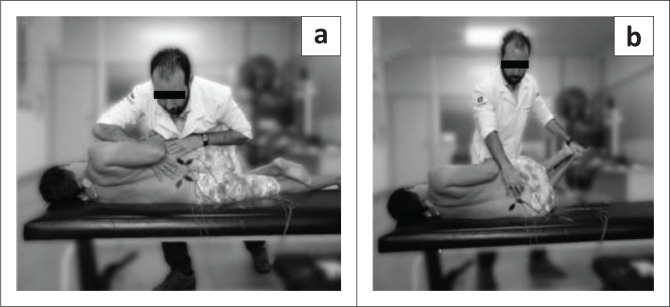This study compared the effectiveness of two osteopathic manipulative techniques on clinical low back symptoms and trunk neuromuscular postural control in male workers with chronic low back pain (CLBP).
Ten male workers with CLBP were randomly allocated to two groups: high-velocity low-amplitude (HVLA) manipulation or muscle energy techniques (MET). Each group received one therapy per week for both techniques during 7 weeks of treatment.

Pain and function were measured by using the Numeric Pain-Rating Scale, the McGill Pain Questionnaire, and the Roland Morris Disability Questionnaire. The lumbar flexibility was assessed by Modified Schober Test. Electromyography (EMG) and force platform measurements were used for evaluation of trunk muscular activation and postural balance, respectively at three different times: baseline, post-intervention, and 15 days later.
Both techniques were effective (p < 0.01) in reducing pain with large clinical differences (-1.8 to -2.8) across immediate and after 15 days. However, no significant effect between groups and times was found for other variables, namely neuromuscular activation, and postural balance measures.
The authors concluded that both techniques (HVLA thrust manipulation and MET) were effective in reducing back pain immediately and 15 days later. Neither technique changed the trunk neuromuscular activation patterns nor postural balance in male workers with LBP.
There is, of course, another conclusion that fits the data just as well: both techniques were equally ineffective.


What kind of journal is this? What sample size calculation comes up with n=12?
The South African journal of physiotherapy
Author(s):
South African Society of Physiotherapists
South African Society of Physiotherapy
NLM Title Abbreviation:
S Afr J Physiother
Title(s):
The South African journal of physiotherapy.
Other Title(s):
Suid-Afrikaanse tydskrif fisioterapie
Continues:
Physiotherapy
Publication Start Year:
1954
Frequency:
Quarterly
Country of Publication:
South Africa
Publisher:
Johannesburg : Journal Committee of the South African Society of Physiotherapists, [1954-
Latest Publisher:
Cape Town : AOSIS OpenJournals
Language:
English, Afrikaans
ISSN:
0379-6175 (Print)
2410-8219 (Electronic)
0379-6175 (Linking)
Coden:
SAJPAI
Electronic Links:
http://www.sajp.co.za/index.php/sajp
Free Electronic Resource
https://www.ncbi.nlm.nih.gov/pmc/journals/3502/
PubMed Central
In:
PubMed: v71n1, 2015-
PMC
Current Indexing Status:
Not currently indexed for MEDLINE.
MeSH:
Physical Therapy Modalities*
Publication Type(s):
Periodical
Notes:
Vols. for Mar. 1966- also have title in Afrikaans: Suid-Afrikaanse tydskrif fisioterapie.
Title from cover.
Also issued online.
Chiefly in English with some abstracts in Afrikaans.
Official publication of the South African Society of Physiotherapists, July 1954-Jan. 1956; of the South African Society of Physiotherapy, Apr. 1956-
Other ID:
(DNLM)S31840000(s)
(OCoLC)05472301
NLM ID:
9816433 [Serial]
I get it, confuse typical patient with all these mumbo jumbo graphs, medical terms and perfection. It works, watch any late night infomercial, people buy emotions and fake science because they were told to. Actually, daytime shows do the same, Dr. Oz has a very big following.
There is no scientific evidence to support the diagnosis or therapeutic effectiveness of osteopathy (OMT Osteopathic Manipulative Treatment) or chiropractic in the area of the ICD-10-listed diseases or clinical pictures.
Apparently they based it off this study, which concluded…
“The previously suggested CPR for identifying patients likely to benefit from LSE could not be validated in this study. However, due to its relatively low level of power, this study could not invalidate the CPR, either.”
Journal of Orthopaedic & Sports Physical TherapyVol. 44, No. 1A Clinical Prediction Rule to Identify Patients With Low Back Pain Who Are Likely to Experience Short-Term Success Following Lumbar Stabilization Exercises: A Randomized Controlled Validation Study